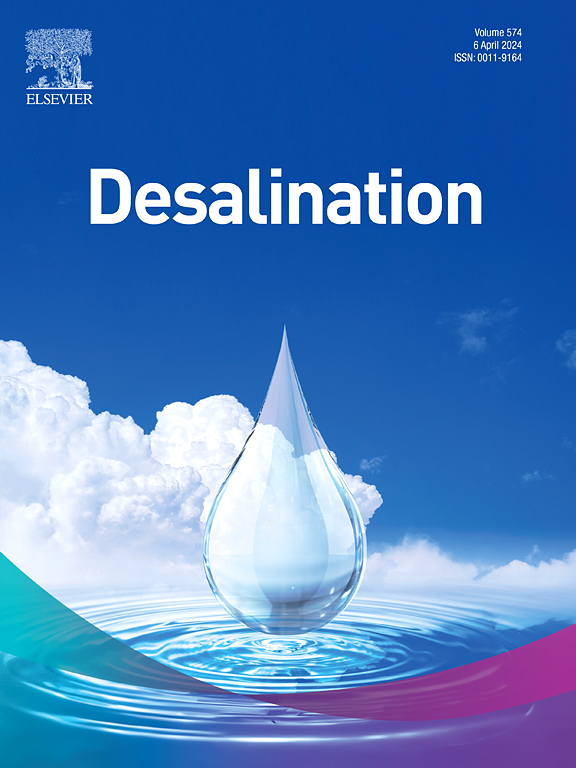High-efficiency electrospun PVDF@MXene composite membrane with covalent bonding and well-dispersed internal materials for solar-driven seawater desalination
IF 8.3
1区 工程技术
Q1 ENGINEERING, CHEMICAL
引用次数: 0
Abstract
Environmentally friendly and efficient solar-driven interfacial evaporation (SDIE) has been increasingly applied to seawater desalination, and the easy-to-operate electrospinning technology has attracted more and more attention. However, photothermal materials such as MXene are often combined with polymers suitable for spinning through ordinary blending. The inherent difficult dispersion of it may lead to the instability of spinning and decrease the performance of evaporators, further hindering their production and application. To address these challenges, this work designs a covalent bonding PVDF@MXene composite as the spinning raw material. Using the electrospinning technology, the high-efficiency membrane-based evaporator with well-dispersed internal materials and strong homogeneity is successfully fabricated. The membrane performance is optimal when the MXene content is 25 %, achieving an evaporation rate of 1.88 kg·m−2·h−1 and an efficiency of 94.06 % under one sun. Besides, it exhibits remarkable salt resistance, maintaining an evaporation rate of 1.81 kg·m−2·h−1 even at the salinity of up to 20 wt%. More importantly, the membrane can be immersed in oxidative reagents for 24 h without degradation or reduced performance, demonstrating its good environmental stability. Overall, this research not only provides a rational idea for addressing the dispersion issue of MXene, but also presents a potential solution to deal with the global freshwater shortage emergency.
具有共价键和良好分散内部材料的高效电纺 PVDF@MXene 复合膜,用于太阳能驱动的海水淡化
环保高效的太阳能驱动界面蒸发(SDIE)已越来越多地应用于海水淡化,而易于操作的电纺丝技术也吸引了越来越多的关注。然而,光热材料(如 MXene)通常与适合纺丝的聚合物通过普通混合方式结合在一起。其固有的难分散性可能会导致纺丝的不稳定性,降低蒸发器的性能,进一步阻碍其生产和应用。为解决这些难题,本研究设计了一种共价键合的 PVDF@MXene 复合材料作为纺丝原料。利用电纺丝技术,成功制备出内部材料分散良好、均匀性强的高效膜基蒸发器。当 MXene 含量为 25% 时,膜的性能达到最佳,蒸发率为 1.88 kg-m-2-h-1,在一个太阳下的效率为 94.06%。此外,它还具有出色的耐盐性,即使在盐度高达 20 wt% 的情况下,蒸发率也能保持在 1.81 kg-m-2-h-1。更重要的是,该膜可在氧化试剂中浸泡 24 小时而不会降解或降低性能,这表明它具有良好的环境稳定性。总之,这项研究不仅为解决 MXene 的分散问题提供了一个合理的思路,也为应对全球淡水短缺的紧急情况提供了一个潜在的解决方案。
本文章由计算机程序翻译,如有差异,请以英文原文为准。
求助全文
约1分钟内获得全文
求助全文
来源期刊

Desalination
工程技术-工程:化工
CiteScore
14.60
自引率
20.20%
发文量
619
审稿时长
41 days
期刊介绍:
Desalination is a scholarly journal that focuses on the field of desalination materials, processes, and associated technologies. It encompasses a wide range of disciplines and aims to publish exceptional papers in this area.
The journal invites submissions that explicitly revolve around water desalting and its applications to various sources such as seawater, groundwater, and wastewater. It particularly encourages research on diverse desalination methods including thermal, membrane, sorption, and hybrid processes.
By providing a platform for innovative studies, Desalination aims to advance the understanding and development of desalination technologies, promoting sustainable solutions for water scarcity challenges.
 求助内容:
求助内容: 应助结果提醒方式:
应助结果提醒方式:


